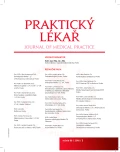New oral anticoagulants – a review
Authors:
A. Pohlídalová 1; J. Janoutová 1; M. Homza 2; V. Janout 1
Authors‘ workplace:
Ostravská Univerzita v Ostravě
Lékařská fakulta
Ústav epidemiologie a ochrany veřejného zdraví
Vedoucí: prof. MUDr. Vladimír Janout, CSc.
1; Fakultní nemocnice Ostrava
Kardiovaskulární oddělení
Primář: MUDr. Miroslav Homza, MBA
2
Published in:
Prakt. Lék. 2016; 96(3): 114-121
Category:
Of different specialties
Overview
Until recently, warfarin was the only anticoagulant used in medical care. Because of its numerous side effects, in particular different types of bleeding, a few new oral anticoagulants with equal or better safety than warfarin were developed. Until now, few drugs have been developed, direct thrombin inhibitors (so-called gatrans) and direct inhibitors of factor Xa (so-called xabans). They have the same or better safety profile, but it should be under a long-term epidemiological watch by experts of their respective specializations, as well as general practitioners. Now practitioners are confronted with a wide range of patients, including patients on anticoagulation therapy. Therefore, it is appropriate that they have a general overview of the new possibilities of anticoagulant therapy. There is also a need for more information on how to manage patients with bleeding because there are no approved specific antidotes for NOACs (Novel Oral Anticoagulants). Due to the relatively short duration of the use of new anticoagulants in practice, only time will reveal other risks of treatment with NOACs, which will need to be addressed.
Keywords:
new oral anticoagulants – dabigatran – apixaban – rivaroxaban – atrial fibrillation – thromboembolic disease
Sources
1. Becattini C, Vedovati MC, Agnelli G. Old and new oral anticoagulants for venous thromboembolism and atrial fibrillation: A review of the literature. Thromb Res 2012; 129(3): 392–400.
2. Camm AJ, Kirchhof P, Lip GY, et al. Guidelines for the management of atrial fibrillation. Eur Heart J 2010; 31 : 2369–2429.
3. Conolly SJ, Eikelboom J, Joyner C. Apixaban in patients with atrial fibrillation. N Engl J Med 2011; 364(9): 806–817.
4. Čihák R, Haman L, Heinc P. Summary of the 2012 focused update of the ESC Guidelines for the management of atrial fibrillation: Prepared by the Czech Society of Cardiology. Cor Vasa 2012; 54(6): e341–e351.
5. Čihák R, Haman L, Táborský M. European Heart Rhythm Association practical guide on the use of new oral anticoagulants in patients with non-valvular atrial fibrillation. Summary of the document prepared by the Czech Society of Cardiology 1. Cor Vasa 2014; 56(1): e42–e56.
6. Čihák R, Heinc P, Haman L, a kol. Fibrilace síní: Doporučený diagnostický a léčebný postup České kardiologické společnosti vypracovaný Pracovní skupinou arytmie. Vnitř. Lék. 2012; 58(Suppl 1): 41–69.
7. Ezekowitz MD, Conolly S, Pareth A, et al. Rationale and design of RE-LY randomised evaluation of long term anticoagulant therapy, warfarin compared with dabigatran. Am Heart J 2009; 157(5): 805–810.
8. Granger CHB, Alexander JH, McMurray JV, et al. for the ARISTOTLE Committees and Investigators. Apixaban versus warfarin in patients with atrial fibrillation. N Engl J Med 2011; 365 : 981–992.
9. January CT, Wann LS, Alpert JS, et al. 2014 AHA/ACC/HRS Guideline for the management of patients with atrial fibrillation: executive summary. Circulation 2014; 130(23): 2071–2104.
10. Karetová D, Bultas J. Nová perorální antitrombotika v prevenci a léčbě tromboembolizmu. Kardiol Rev Int Med 2012; 14(2): 88–92.
11. Kvasnička J, Penka M, Kvasnička T, a kol. Doporučení české společnosti pro trombózu a hemostázu České lékařské společnosti J. E. Purkyně pro bezpečnou léčbu novými perorálními antikoagulancii (NOAC) – dabigatran exilátem, apixabanem a rivaroxabanem. Vnitř. Lék. 2015; 61(6): 537–546.
12. Lloyd-Jones DM. Lifetime risk for development of atrial fibrillation: the Framingham Heart Study. Circulation 2004; 110(9): 1042–1046.
13. Mak KH. Coronary and mortality risks in novel oral antithrombotic agents: a meta-analysis of large randomized trials. Interv Akut Kardiol 2013; 12(3): 142–148.
14. Patel MR, Mahaffey KW, Garg J. Rivaroxaban versus warfarin in nonvalvular atrial fibrillation. N Engl J Med 2011; 365(10): 883–891.
15. Pradaxa® Prescribing Information 2014 [online]. Dostupné z: http:// http://docs.boehringer-ingelheim.com/PrescribingInformation/PIs/Pradaxa/Pradaxa.pdf
16. Sionova M, Blasko P, Jirous S, et al. Number of severe bleeding complications according to classification used: is unified classification of bleeding complications really necessary? Cardiol Rev 2015; 22(4): 1–21.
17. Špinar J, Lábrová R. Antikoagulační léčba u fibrilace síní. Remedia 2011; 21(2): 168–171.
18. Špinar J, Vítovec J, Špinarová L, Musil V. Profile of Czech AF 2012. Profile of atrial fibrillation patients receiving antithrombotic therapy: Czech Republic 2011. Cor Vasa 2014; 56(3): e207–e216.
19. Táborský M. Fibrilace síní: novinky v léčbě 2013. Praha: Axonite CZ 2013.
20. Vojáček J. Klinické zkušenosti s novými perorálními antitrombotiky a některé zatím nezodpovězené otázky. Interv Akut Kardiol 2014; 13(2): 92–98.
Labels
General practitioner for children and adolescents General practitioner for adultsArticle was published in
General Practitioner

2016 Issue 3
- Memantine in Dementia Therapy – Current Findings and Possible Future Applications
- Metamizole at a Glance and in Practice – Effective Non-Opioid Analgesic for All Ages
- Advances in the Treatment of Myasthenia Gravis on the Horizon
- Hope Awakens with Early Diagnosis of Parkinson's Disease Based on Skin Odor
- Metamizole in perioperative treatment in children under 14 years – results of a questionnaire survey from practice
Most read in this issue
- Fine motor skills disorders in general practice
- Larva migrans cutanea – an imported skin disease and possibilities of treatment
- New oral anticoagulants – a review
- Ankle brachial index and its interpretation in diabetic patients
